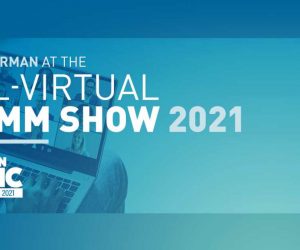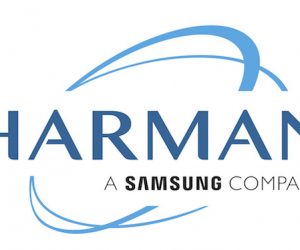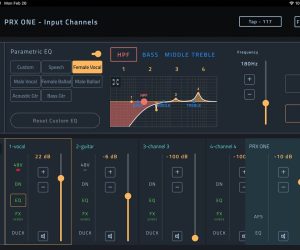
In Harman’s Way
When Harman acquired Aussie manufacturer SM Pro for its technology, it wasn’t just about coming up with the goods.
New Harman employees, Danny Olesh and John Fuller, are sitting in their R&D suite fine-tuning the firmware on their baby before it hits the production line. In front of them sits a prototype rackmount mixer, of which Olesh and Fuller designed the guts, form factor, and software. Previously, it was called the uMix, the final hurrah of the pair’s SM Pro line. These days, it’s dressed in full Soundcraft livery.
Other than a couple of hundred grand worth of stock worldwide that will trickle down off shelves over the next couple of months, SM Pro is now no more. All its IP has been acquired by Harman as part of the deal that turned the uMix into the Soundcraft Ui series; will see some SM Pro bits-and-pieces distributed across Harman’s brands and others sunsetted; and added Danny, John and their team to the Harman family. Soon, all that’s left of the brand will be the shelves in this room, stacked with the remnants of the SM Pro line; black with red-accented artefacts of an Australian audio manufacturer that could.
SM GOES PRO
The SM Pro line of products came out of the distribution company, Sound & Music, hence the ‘SM’ name. But distributing and developing products have gone hand in hand since the beginning. At the time, Danny had been building turnkey audio playback and scheduling systems with software he wrote for community radio stations. It filled a niche; an affordable system that fulfilled the stations’ need. When John saw the Guillemot ISIS sound card Danny was using for the systems, he thought it — one of the first multi-channel cards, and the first to be bundled with Logic — would make a great MI product. It sold loads, and Sound & Music, the distribution company, was off and racing.
The SM Pro line started in 2001, but it wasn’t till 2004 that the brand really cemented its MO, “Useful tools, at affordable prices,” said John. “Probably the most successful part of the brand were the passive attenuators. We seemed to find a little spot in the market where they were priced right, and worked well. There’s not much electronics in a passive controller, so you can’t really go that far wrong.”
There were also portable preamps, the Mic Thing mic isolator, headphone amps, and the V-Machine, a portable VST/VSTi plug-in player that the pair really cut their teeth on, and set them up for attempting the uMix. “We learnt a lot about tech, project management, managing finances and factory integration,” said John. “We learnt from a lot of mistakes, and tried to do it better this time.”
The idea for the original uMix came from Sound & Music Sales Manager, Michael Jago. He’d spent a year working high up in sales and management for Behringer and Samson, and saw a gap in the market for low-cost digital mixers. This was before Mackie had entered the market with its DL range, and long before the current crop of digital rackmount mixers, when every digital desk was in the thousands of dollars, not the hundreds. Michael was the only one from the team not to join Harman. He felt he’d rather stay with Sound & Music than make the leap into the arms of another international company.
FUTURE ISN’T NATIVE
Soundcraft first cottoned onto the uMix at the 2014 Musikmesse tradeshow, where it was being demonstrated, and were suitably impressed. Not only with the product, but by the team’s intent. By programming the software to run in HTML5 browsers instead of native apps, it was multi-platform and multi-device. It also lines up perfectly with the buzz-phrase of the tech world: the ‘internet of things’.
“Originally, we said, who are we building it for?” said John. “Which, thinking as SM Pro at the time, was probably different than if we’d been doing it for Harman. Most of our reach was in Europe and smaller markets, because our gear was cheaper than others.
“We were looking at developing markets, and figured we had to be low cost, which meant low-cost development as well. For us to do it any other way meant more development work — for iOS, Android and Windows — and more maintenance work as well. HTML5 is a developing standard, but now it’s very solid across all of those platforms.
“We did some proof of concept tests because we knew we had to maintain the quality and feel of a native app. Once we’d assured ourselves, we continued down that path.
“Then we saw all the other advantages of using HTML5. If people’s devices go down, and they haven’t got any local 3G or 4G service to download a new app on a new phone, all they have to do with ours is pull out another device and directly connect to our wi-fi. Regarding downtime, if an iPad runs out of power, they can jump on a desktop or laptop and still control the mix.”
Of course, an open standard is all well and good. Though anyone that’s ever struggled with a slow internet connection would be dubious about the reliability of anything HTML-related for audio control. But it’s not actually transmitting via the internet. It’s a closed loop. Playing with the prototype Soundcraft Ui, it’s incredibly snappy. Snappier than some of its native counterparts. “There’s an ARM chip inside, which runs a web server holding all our code,” explained John. “So when you request it, just like a website, it delivers it all to the browser. We’re not doing individual requests, it’s a live HTML5 web socket open at all times for real-time data streaming. As you make a movement on the GUI, it sends data back to the web server, which in turn sends messages to the CPU to drive the mixer and SHARC DSP. Similarly, any changes to the DSP are sent back, telling the Javascript code on the client side to update the UI.
“What you’re seeing is basically a string of data telling it to re-render, re-render. And it’s doing it fast! It paints even faster than native apps.”



The initial SM Pro red and grey uMix, before being transformed with Blue Soundcraft livery, double the DSP, added algorithms, better quality connectors and preamps.
SEED OF NEED
By the time Musikmesse rolled around, the project had been two years in development and was almost there, but there was still a lot of investment needed. Both Danny and John’s houses had been on the line, and EMDG grants had helped market it. “We were at a point where we had a great product,” said John. “But to go to market and try and fight Behringer, Presonus, or Soundcraft for that matter… they could just squash us. We would have gone to market anyway, but it was great that Harman could get us across the line.
“For us to push production of the quantities we thought we were going to sell, we’d have to pony up a lot of money to procure all the parts; we’re talking about buying 10,000 ARM chips. We were at a position where we sort of needed Harman, and Harman sort of needed us.
“It wasn’t just that. Harman put out a statement about why they purchased us, and it was about getting some good tech they could see sprinkling through their future plans. They can visualise a whole concept for the ‘internet of things’, and felt what we developed can play a part in that. But they also liked the team we had.”
Danny, John and their team of free-thinking mavericks are under Andy Trott and VP Mark Ureda’s Future Technologies group. So while, technically, because of this first project, they fall under the Soundcraft banner, they’re already fielding Skype calls from boffins inside the other Harman camps.
STABLE MATES
It’s that kind of cross-brand pollination that makes Harman so formidable. Behind the Soundcraft badge, there’s a cavalcade of contributions dragged in from all throughout the Harman stable. Digitech has supplied an amp modeller for the first two Hi-Z capable inputs; Lexicon dropped in a reverb algorithm and some effects; and dbx came to the party with a very handy feedback suppression circuit. It’s a Harman love-in. And, of course, Soundcraft chipped in considerable knowledge on the preamp and electronics side, not to mention the upsides of being backed by a global corporation.
“We were surprised by how big Harman are,” said John. “They were just talking in figures we’d never thought of. Once you’re talking about the numbers they’re talking about, all the part costs come down. Harman has access to Neutriks at rates we wouldn’t have had a hope in hell of getting. They’ve got guys that do very specific jobs, whereas we were trying to do everything — write the manuals, website updates, press releases.
“They can get everything. They’ve improved elements. They’ve got a lot of smarts in there; like how to do preamps in particular ways. They’ve got great engineers. They’ve made a lot of suggestions along the way: different ways of connecting PCBS, for instance; ways of making it more reliable and to save money.”
SM PRO NO MO’
Shifting through the shelves of retired SM Pro gear, I asked Danny and John if they were sad to see the brand go. “It was a nice journey, from where we started, going to NAMM, all that,” reflected Danny. “But I don’t think we were ever attached to the name.” For them it’s just a bigger, better platform to get their ideas out. And so far, even though they’re in the same room upstairs at Sound & Music’s Moorabbin HQ, things are looking pretty good from inside Harman. “They’ve been really great, and are supportive of new ideas and seeing how it can all go together,” said John. “We’ve really enjoyed being stretched and taking it further than we would have.”
















RESPONSES